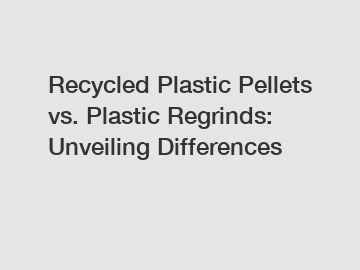Dec. 22, 2023
Environment
Recycled Plastic Pellets vs. Plastic Regrinds: Unveiling Differences.
Plastic recycling has become an increasingly important process in tackling the global issue of plastic waste. Two commonly used products in the recycling industry are recycled plastic pellets and plastic regrinds. While they may seem similar at first glance, there are distinct differences between the two. In this article, we will unveil these differences, shedding light on their unique characteristics and uses.
Recycled Plastic Pellets: What Sets Them Apart?

1. Definition and Manufacturing Process.
Recycled plastic pellets are small, uniformly shaped granules produced by melting down plastic waste and reforming it into tiny beads. This process involves sorting and cleaning the plastic waste, melting it, and extruding it through small holes to form pellets. Through this transformation, the plastic waste is given a new life, reducing the strain on the environment by diverting it from landfills or incineration.
2. Quality and Consistency.
One key advantage of recycled plastic pellets is their consistent quality. Due to their manufacturing process, they generally have a more uniform size and shape compared to plastic regrinds. This consistency makes them highly suitable for injection molding or extrusion processes, where precise dimensions and properties are crucial. Additionally, recycled plastic pellets often undergo strict quality control measures to ensure they meet industry standards, making them a reliable option for manufacturers.
3. Versatility in Applications.
Recycled plastic pellets find extensive use in various industries, including packaging, automotive, construction, and more. Their versatility allows these pellets to be used in a wide range of applications, such as the production of plastic bottles, containers, pipes, and even textiles. The ability to transform plastic waste into high-quality pellets enables businesses to contribute to a circular economy while benefiting from the cost savings of using recycled materials.
Further reading:Plastic Regrinds: Uncovering Their Unique Characteristics.
1. Definition and Manufacturing Process.
Plastic regrinds, also known as regrind plastics, are small plastic fragments produced by grinding down post-industrial or post-consumer plastic products. The process involves taking plastic waste, such as scraps or discarded products, and reducing them to granules or powders. Regrinds are often the byproduct of plastic manufacturing or recycling processes, providing a secondary use for plastic waste.
2. Variability in Size and Shape.
Unlike recycled plastic pellets, plastic regrinds do not undergo the same level of processing, resulting in a wider range of sizes and shapes. Regrinds may vary in particle size, from fine powders to larger granules, depending on the specific recycling process and the source of the plastic waste. This variability can make them suitable for certain applications where consistency in size and shape is not critical, such as landscaping materials or filler in lower-grade plastic products.
3. Niche Applications.
Plastic regrinds are commonly used in applications that do not require strict quality standards or precise dimensions. Their lower cost compared to recycled plastic pellets makes them a more economical option for certain industries, like building and construction, where the appearance or exact specifications may not be as essential. Regrinds can be used for manufacturing items such as plastic furniture, pallets, or non-food contact items.
In conclusion, recycled plastic pellets and plastic regrinds are both valuable products in the plastic recycling industry. Their differences lie in their manufacturing processes, quality and consistency, versatility, and applications. While recycled plastic pellets excel in industries that require consistent quality and precise specifications, plastic regrinds find their niche in cost-sensitive applications that do not demand strict standards. By understanding these distinctions, businesses can choose the most suitable option to support sustainability goals and contribute to a greener future.
For more information on recycled plastic pellets, plastic regrinds, or any other plastic recycling solutions, please feel free to contact us. We would be happy to assist you in finding the right recycling solution for your unique needs.
If you are looking for more details, kindly visit rPET pellets, rPET pellets, rPET pellets.
Further reading:Related Articles
If you are interested in sending in a Guest Blogger Submission,welcome to write for us!
All Comments ( 0 )